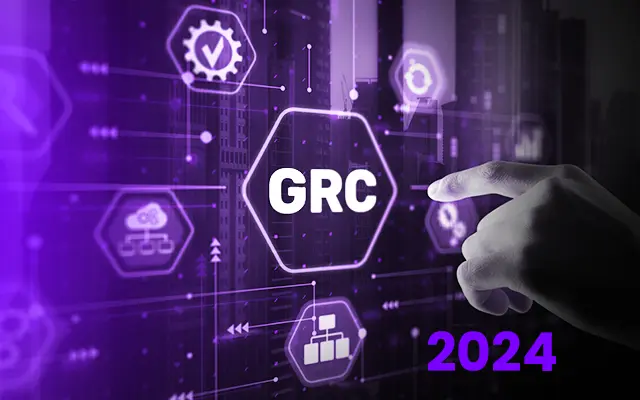In today’s rapidly evolving digital landscape, organisations are facing unprecedented cybersecurity challenges. With cyber threats becoming increasingly sophisticated, it has never been more crucial for businesses to enhance their cybersecurity posture. One of the most effective ways to achieve this is by implementing a robust Governance, Risk Management, and Compliance (GRC) framework. In this blog post, we will explore the role of GRC in 2024 in strengthening cybersecurity posture, discuss key strategies, and highlight the benefits of integrating GRC into your cybersecurity strategy.
What is GRC?
Governance, Risk Management, and Compliance (GRC) is a comprehensive framework that helps organisations identify, assess, and manage risks effectively while ensuring compliance with relevant regulations and standards. GRC encompasses three key components:
- Governance: Refers to the overall management and oversight of an organisation’s cybersecurity policies, procedures, and controls.
- Risk Management: Involves identifying, assessing, and prioritising cybersecurity risks and implementing appropriate controls to mitigate these risks.
- Compliance: Ensures that the organisation adheres to relevant laws, regulations, and industry standards related to cybersecurity.
The Role of GRC in Strengthening Cybersecurity Posture
1. Proactive Risk Management
In 2024, cyber threats are becoming more sophisticated and unpredictable. Organisations need to adopt a proactive approach to identify, assess, and mitigate cybersecurity risks effectively. GRC provides a structured framework for conducting risk assessments, implementing appropriate controls, and monitoring the effectiveness of these controls continuously. By integrating GRC into your cybersecurity strategy, you can identify vulnerabilities proactively and take timely action to mitigate potential risks.
2. Enhanced Compliance Management
With the increasing number of cybersecurity regulations and standards, compliance has become a significant challenge for organisations. GRC helps organisations streamline compliance management by providing a centralised platform to manage and monitor compliance with relevant laws, regulations, and industry standards. By automating compliance workflows and conducting regular compliance audits, organisations can ensure that they adhere to regulatory requirements and avoid costly penalties.
3. Improved Decision-Making
GRC provides organisations with valuable insights into their cybersecurity posture by consolidating and analysing data from various sources, such as risk assessments, compliance audits, and security incidents. This enables organisations to make informed decisions and prioritise cybersecurity initiatives effectively. By aligning cybersecurity strategies with business objectives and risk tolerance levels, organisations can optimise resource allocation and maximise the effectiveness of their cybersecurity investments.
Strategies for Implementing a Robust GRC Framework
1. Establish Clear Governance Structure
To ensure effective governance, organisations need to establish a clear governance structure with defined roles, responsibilities, and decision-making processes. This includes appointing a Chief Information Security Officer (CISO) or a virtual CISO (vCISO) to oversee cybersecurity initiatives and ensure alignment with business objectives and risk tolerance levels.
2. Conduct Comprehensive Risk Assessments
Organisations should conduct comprehensive risk assessments to identify and assess cybersecurity risks proactively. This involves identifying potential threats and vulnerabilities, assessing the potential impact of these risks, and prioritising them based on their severity and likelihood of occurrence. By conducting regular risk assessments, organisations can identify vulnerabilities and implement appropriate controls to mitigate potential risks effectively.
3. Streamline Compliance Management
To streamline compliance management, organisations should implement automated compliance management solutions that enable them to manage and monitor compliance with relevant laws, regulations, and industry standards effectively. This includes automating compliance workflows, conducting regular compliance audits, and generating compliance reports to demonstrate adherence to regulatory requirements.
4. Implement Continuous Monitoring and Improvement
Continuous monitoring is crucial for maintaining a strong cybersecurity posture. Organisations should implement continuous monitoring solutions that enable them to monitor the effectiveness of their cybersecurity controls continuously. This includes monitoring security events, analysing security logs, and conducting regular security assessments to identify and mitigate potential risks proactively. By implementing continuous monitoring solutions, organisations can detect and respond to cybersecurity incidents promptly and minimise the impact of security breaches.
Benefits of Integrating GRC into Your Cybersecurity Strategy
1. Enhanced Cybersecurity Posture
By implementing a robust GRC framework, organisations can enhance their cybersecurity posture by proactively identifying, assessing, and mitigating cybersecurity risks effectively. This enables organisations to strengthen their defences against cyber threats and minimise the likelihood and impact of security breaches.
2. Streamlined Compliance Management
GRC helps organizations streamline compliance management by providing a centralized platform to manage and monitor compliance with relevant laws, regulations, and industry standards. By automating compliance workflows and conducting regular compliance audits, organizations can ensure that they adhere to regulatory requirements and avoid costly penalties.
3. Improved Decision-Making
GRC provides organizations with valuable insights into their cybersecurity posture by consolidating and analysing data from various sources, such as risk assessments, compliance audits, and security incidents. This enables organisations to make informed decisions and prioritise cybersecurity initiatives effectively, optimising resource allocation, and maximising the effectiveness of their cybersecurity investments.
How Technivorus Can Help in GRC Services
At Technivorus, we understand the complexities of cybersecurity and the challenges organisations face in managing risks and ensuring compliance. Our GRC services are designed to help organisations implement a robust GRC framework tailored to their unique needs and requirements. Our team of experienced cybersecurity professionals can assist you in:
- Establishing a clear governance structure with defined roles, responsibilities, and decision-making processes.
- Conducting comprehensive risk assessments to identify and assess cybersecurity risks proactively.
- Implementing automated compliance management solutions to streamline compliance management and ensure adherence to regulatory requirements.
By partnering with Technivorus for your GRC services, you can enhance your cybersecurity posture, streamline compliance management, and improve decision-making, enabling you to strengthen your defences against cyber threats effectively.
Conclusion
In 2024, the role of GRC in strengthening cybersecurity posture has become more critical than ever. By implementing a robust GRC framework and adopting key strategies, organisations can enhance their cybersecurity posture, streamline compliance management, and improve decision-making, enabling them to strengthen their defences against cyber threats effectively. Partnering with Technivorus for your GRC services can help you navigate the complexities of cybersecurity, ensuring that you are well-equipped to manage risks and ensure compliance effectively.

